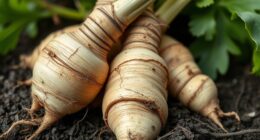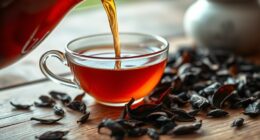Have you ever wondered what to do with those leftover stems from your fresh herbs? Well, I have a solution for you – making herbal tea using stems! It’s a wonderful way to utilize every part of your herbs and create a delicious and soothing beverage.
In this article, I will guide you through the process step by step, sharing my knowledge and expertise on how to make the perfect herbal tea using stems. By infusing the stems in hot water, you can extract their aromatic and medicinal properties, resulting in a flavorful and beneficial drink.
I will also show you how to enhance the flavor with additional ingredients and how to strain and serve your homemade herbal tea. So, let’s get started on this exciting journey of exploring different herbal combinations and variations to create the most delightful and refreshing herbal tea using stems.
Key Takeaways
- Utilize leftover herb stems to make herbal tea
- Choose healthy stems without signs of disease or pests
- Harvest stems in the morning for the best flavor
- Enhance the flavor with additional ingredients like honey or lemon
Choose the Right Stems
When making herbal tea using stems, it’s important to choose the right ones for maximum flavor and benefits. Different types of herbal tea stems can be used, such as chamomile, peppermint, or lemon balm. Each stem imparts its unique taste and health benefits, so it’s essential to select the one that suits your preferences and needs.
When harvesting herbal tea stems, there are a few tips to keep in mind. Firstly, choose stems that are healthy and free from any signs of disease or pests. Secondly, harvest the stems in the morning when the flavor is at its peak. Lastly, cut the stems at a 45-degree angle to promote healthy regrowth.
Once you’ve gathered and prepared your stems, it’s time to move on to the next step of gathering and preparing your ingredients.
Gather and Prepare Your Ingredients
To create a delightful infusion, start by collecting and preparing the essential elements. When making herbal tea using stems, there are various types you can choose from, each offering unique flavors and benefits. Stems from herbs like mint, chamomile, and lavender can be used to make refreshing and soothing teas.
It’s important to use fresh ingredients for the best results. Fresh stems provide a stronger and more vibrant taste to your tea, enhancing its aroma and therapeutic properties. By using fresh ingredients, you ensure that the tea is packed with the maximum amount of nutrients and antioxidants.
Once you’ve gathered your stems, it’s time to infuse them in hot water, allowing their essence to steep and create a nourishing and flavorful tea.
Infuse the Stems in Hot Water
Once you’ve gathered your fresh stems, immerse them in hot water to unlock their aromatic essence and create a nourishing and flavorful infusion. Using dried stems is also an option if fresh ones aren’t available.
Start by bringing water to a boil in a pot or kettle. While the water is heating, rinse the stems thoroughly to remove any dirt or impurities. Once the water reaches a rolling boil, carefully add the stems and reduce the heat to a simmer. Allow the stems to steep for at least 5 minutes, but you can leave them longer if you prefer a stronger flavor.
After the steeping time, strain the liquid to remove any remaining plant material. Now, you have a delightful herbal tea base ready to be enhanced with additional ingredients, such as honey or lemon, to further elevate its taste and aroma.
Enhance the Flavor with Additional Ingredients
Adding a touch of honey or a squeeze of lemon can take your herbal infusion to the next level, making it a tantalizing treat for your taste buds. When it comes to enhancing the flavor of herbal tea made from stems, there are various options to choose from. Different types of sweeteners, such as honey, maple syrup, or stevia, can add a delightful sweetness to your tea. These natural sweeteners not only enhance the taste but also provide additional health benefits.
Another way to elevate the flavor is by adding citrus fruits like lemon or orange. Citrus fruits not only add a refreshing tang but also bring their own set of health benefits, including vitamin C and antioxidants. By incorporating these additional ingredients, you can create a unique and flavorful herbal tea that is both delicious and beneficial for your well-being.
Now, let’s move on to the next step of straining and serving your herbal tea.
Strain and Serve Your Herbal Tea
When it comes to straining and serving herbal tea, there are two main methods that I find most effective.
The first is using a fine mesh strainer, which helps remove any small particles or residue from the tea leaves or additional ingredients. This ensures a smooth and clean cup of tea.
The second method is using a tea infuser, which is especially useful when using loose tea leaves. The infuser holds the leaves while allowing the hot water to flow through, resulting in a perfectly brewed cup of herbal tea.
Using a Fine Mesh Strainer
To extract the full flavor and aroma of the herbal tea, simply pour the steeped mixture through a fine mesh strainer, allowing the fragrant liquid to effortlessly flow into your awaiting cup.
When it comes to straining your herbal tea, using a fine mesh strainer is a great choice. While there are alternative straining methods like using a cheesecloth or a coffee filter, a fine mesh strainer offers distinct benefits. Firstly, it effectively filters out any small particles or debris, ensuring a smooth and clean cup of tea. Additionally, the fine mesh allows the flavors and essential oils to pass through, resulting in a more flavorful and aromatic brew.
Using a fine mesh strainer is a convenient and efficient way to strain your herbal tea.
Now, let’s move on to the next step: using a tea infuser.
Using a Tea Infuser
If you’re a tea lover, using a tea infuser is a game-changer for brewing your favorite blends. There are different types of tea infusers available, each with its own unique features and benefits.
One common type is the ball infuser, which is a small metal mesh ball that opens up to hold loose tea leaves. Another popular option is the basket infuser, which is a larger mesh basket that sits inside your mug or teapot. Both types allow the tea leaves to steep freely in hot water, releasing their flavors and aromas.
The pros of using a tea infuser are that it provides a convenient and mess-free way to brew loose leaf tea. It also allows for better control over the strength of the tea, as you can remove the infuser once your desired flavor is achieved. However, one potential con is that some tea infusers may not be large enough to accommodate certain types of herbal tea stems or larger botanicals.
Now, let’s move on to the next section about how to store and enjoy your homemade herbal tea…
Store and Enjoy Your Homemade Herbal Tea
First, savor the delightful taste of your homemade herbal tea by finding a cozy spot and allowing yourself to fully enjoy the moment.
After preparing and steeping your tea, it’s important to store it properly to maintain its freshness and flavor. Store your herbal tea in an airtight container in a cool, dark place to prevent exposure to light and moisture. This will help preserve its aroma and taste for longer.
When it comes to enjoying your homemade herbal tea, there are endless possibilities. Get creative and try adding a slice of lemon or a sprig of mint for a refreshing twist. You can also experiment with serving it over ice or adding a touch of honey for added sweetness.
And now, let’s explore different herbal combinations and variations to elevate your tea experience.
Explore Different Herbal Combinations and Variations
Indulge in the exciting world of herbal alchemy, where you can mix and match an array of flavors and scents to create your own unique tea blends. Here are four different tea flavors to explore and enjoy, each with its own distinct health benefits:
-
Chamomile and lavender: This combination offers a soothing and calming effect, perfect for relaxation and stress relief. It can also aid in promoting better sleep.
-
Peppermint and lemon balm: With its refreshing and invigorating taste, this blend is known for its digestive benefits. It can help soothe an upset stomach and relieve bloating.
-
Ginger and turmeric: This powerful duo is packed with anti-inflammatory properties, making it great for boosting immunity and reducing inflammation in the body.
-
Hibiscus and rosehip: A tart and tangy blend that is rich in antioxidants. It can support heart health and help lower blood pressure.
Experiment with these different herbal combinations and variations to discover your favorite flavors and reap the health benefits they offer. Cheers to a delightful and healthy herbal tea journey!
Frequently Asked Questions
Can I use any kind of stems to make herbal tea, or are there specific ones that work best?
Using different types of stems for herbal tea can yield various benefits. For instance, chamomile stems aid in digestion, while peppermint stems alleviate headaches. Choosing specific stems tailored to your needs maximizes the therapeutic properties of your tea.
How long should I let the stems infuse in hot water to get the best flavor?
To maximize flavor in herbal tea using stems, it’s important to let them infuse in hot water for at least 10-15 minutes. This allows the flavors to fully develop and enhances the taste of the tea.
Are there any additional ingredients that can help enhance the medicinal properties of the herbal tea?
To enhance the medicinal properties of herbal tea, potential synergistic combinations of herbs can be used. Additionally, techniques such as longer steeping time, hotter water temperature, and covering the tea while steeping can maximize the extraction of medicinal compounds.
Can I reuse the stems to make another batch of herbal tea, or should I discard them after one use?
I recommend discarding the stems after one use. Reusing tea stems may result in a weaker and less flavorful batch of herbal tea. It’s best to use fresh stems each time to maximize the benefits.
Are there any specific storage tips to ensure the longevity and freshness of my homemade herbal tea?
To ensure the longevity and freshness of my homemade herbal tea, I recommend storing it in an airtight container in a cool, dark place. Using fresh stems for making the tea provides maximum flavor and health benefits.
Conclusion
Well, who knew that those seemingly useless stems could be transformed into a delicious cup of herbal tea? It’s amazing what a little creativity and experimentation can do.
So, go ahead and give it a try! With the right stems, ingredients, and a dash of imagination, you can brew yourself a unique and refreshing herbal tea. Who needs fancy tea bags when you can make your own?
Cheers to the unexpected wonders of nature!










